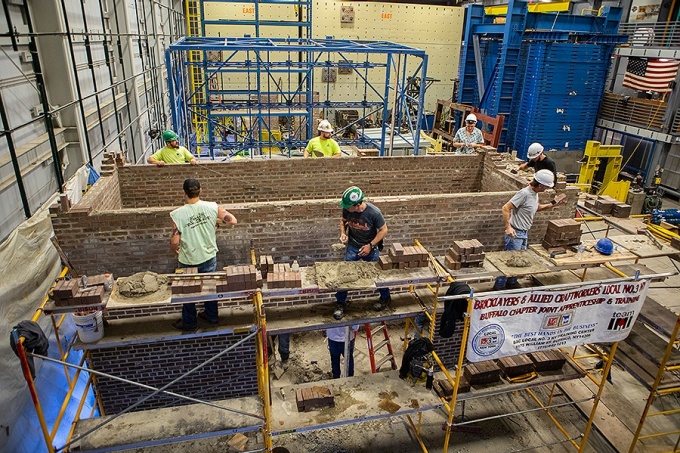Here is how we protect communities from earthquakes

A University at Buffalo project is conducting the largest earthquake test of a full-scale brick and mortar building on a shake table in the United States.
Findings from the research may directly influence American Society of Civil Engineers codes and standards, and lead to the design of more reliable and cost-effective methods to retrofit exisiting structures. The project, funded by the National Institute of Standards and Technology, is led by UB's Andreas Stavridis, associate professor of structural engineering and deputy director of the Structural and Earthquake Engineering Simulation Laboratory (SEESL) in the UB School of Engineering and Applied Sciences.
Unreinforced masonry (URM)—or brick and mortar—buildings are everywhere and are well known for their seismic vulnerability. Residences, stores, restaurants, schools, fire departments and other critical infrastructure are commonly housed in unreinforced masonry buildings.
“In every city I have visited following a devastating earthquake in Europe, Asia and Latin America, URM buildings are the most damaged ones," says Stavridis.
"We want to improve the performance of existing URM buildings during extreme loading events, like earthquakes," he says. "We also want to improve their resilience; that is, ensure they are able to recover and function after such events in a reasonable amount of time with minimal interventions and costs."

Largest structure of its kind tested in U.S.
UB’s SEESL is one of the few spaces in the country capable of carrying out a test of this magnitude, according to Stavridis, noting that tests of full-scale structures can be both complex and expensive.
Construction of the test structure began in January with the help of Job Corps, the largest free residential education and job training program for young adults. Through a partnership with the Iroquois Job Corps Center in Medina, the program provides students with real-world experience building structures alongside professional engineers, UB faculty and graduate students, and apprentices in the Bricklayers and Allied Craftworkers Local No. 3 union in Buffalo. The project also offers Job Corps students a glimpse into structural engineering research.
The structure is outfitteed with more than 160 sensors to help the researchers fill a substantial void in the data on how URMs behave during earthquakes. The results may ultimately lead to safer structures for owners and occupants.

